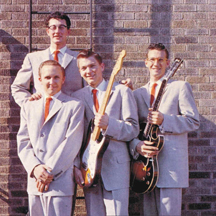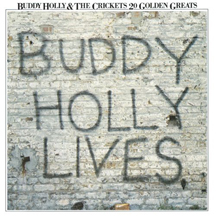

Buddy Holly and the Crickets – 20 Golden Hits (1978): Buddy Holly is the best known of three early rock and roll stars who died in an airplane crash on February 3, 1959, that was immortalized by Don McLean as “the day the music died” in his song “American Pie” (1971). Is there room for Buddy Holly in the top levels of the pantheon of rock and roll pioneers? You’d better believe it. First of all, Buddy Holly is a first-rate songwriter (many of his songwriting credits are in the name of Charles Hardin, taken from his real name, Charles Hardin Holley). Rather than adapting traditional songs and musical styles, what he was writing was brand new. Holly brought a level of sophistication to his recordings that was also new to rock and roll. Additionally, even before he became a star, Buddy Holly primarily made his records at an independent recording studio operated by Norman Petty in New Mexico and was not bound by record company policies and union rules that stultified numerous musicians in those days. For a variety of reasons, some of his singles were released under the name Buddy Holly, and others as the Crickets (often with Buddy Holly’s name nowhere in sight, even as a songwriter). In spite of this, Buddy Holly and/or the Crickets had numerous hit songs, among them “Not Fade Away”, “Everyday”, “Listen to Me”, “Oh Boy!”, “Peggy Sue”, “Maybe Baby”, “Rave On”, “Heartbeat”, and “It’s So Easy”. There were indications that Buddy Holly was beginning to eclipse even Elvis Presley in popularity, particularly in England but also in America. For one thing, Buddy Holly and the Crickets toured the United Kingdom for a month in 1958 (they were only the second white rock band to do so), which Elvis never did, at least in those days. Elvis Presley went into the Army in early 1958 – though his record company had plenty of future hits in the can, he was clearly no longer on the scene. Meanwhile, Buddy Holly was at the height of his powers as a musician. Buddy Holly split from both the Crickets and Norman Petty in the fall of 1958 and was thus free to pursue his new musical visions. Unfortunately, he got only a meager settlement when Norman Petty’s books were found to be in hopeless disarray – probably Petty took a big slice of the pie for himself, though there was no way to prove it. With a new, pregnant wife, and short on money, Buddy Holly signed on for the “Winter Dance Party” package tour of the Midwest. It was during this tour that Buddy Holly was killed in the airplane crash, along with Ritchie Valens, The Big Bopper, and the pilot Roger Peterson. Buddy Holly was just 22 years old – the same age as John Lennon and Ringo Starr when the Beatles became superstars. More than a few British rock groups adopted band names in tribute to Buddy Holly. The Beatles in part took their insect-oriented name from that of his band the Crickets. One Manchester band of the British Invasion period simply called themselves the Hollies. Yet another British Invasion band, the Searchers took their name from the John Wayne movie of that name, The Searchers, where the Duke often said, “That’ll be the day”; the catch phrase had been adopted by Buddy Holly as the name of one of his first hits, “That’ll Be the Day”. 20 Golden Hits collects most of the essential Buddy Holly classics.





